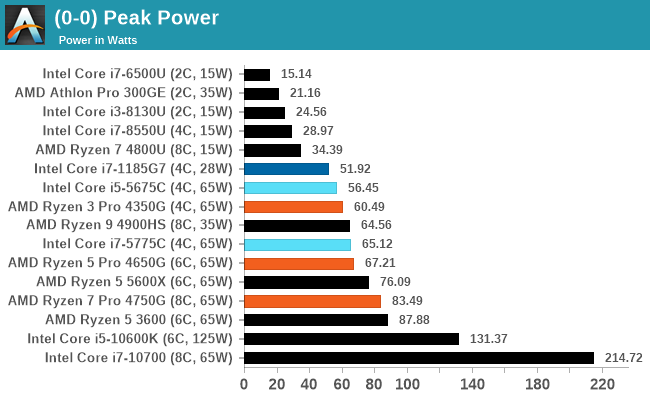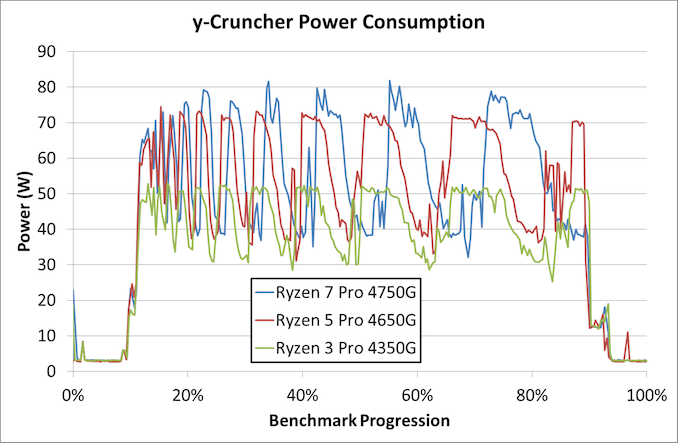Testing The World’s Best APUs: Desktop AMD Ryzen 4750G, 4650G and 4350G
by Dr. Ian Cutress on December 16, 2020 10:30 AM ESTPower Consumption
The nature of reporting processor power consumption has become, in part, a dystopian nightmare. Historically the peak power consumption of a processor, as purchased, is given by its Thermal Design Power (TDP, or PL1). For many markets, such as embedded processors, that value of TDP still signifies the peak power consumption. For the processors we test at AnandTech, either desktop, notebook, or enterprise, this is not always the case.
Modern high performance processors implement a feature called Turbo. This allows, usually for a limited time, a processor to go beyond its rated frequency. Exactly how far the processor goes depends on a few factors, such as the Turbo Power Limit (PL2), whether the peak frequency is hard coded, the thermals, and the power delivery. Turbo can sometimes be very aggressive, allowing power values 2.5x above the rated TDP.
AMD and Intel have different definitions for TDP, but are broadly speaking applied the same. The difference comes to turbo modes, turbo limits, turbo budgets, and how the processors manage that power balance. These topics are 10000-12000 word articles in their own right, and we’ve got a few articles worth reading on the topic.
- Why Intel Processors Draw More Power Than Expected: TDP and Turbo Explained
- Talking TDP, Turbo and Overclocking: An Interview with Intel Fellow Guy Therien
- Reaching for Turbo: Aligning Perception with AMD’s Frequency Metrics
- Intel’s TDP Shenanigans Hurts Everyone
In simple terms, processor manufacturers only ever guarantee two values which are tied together - when all cores are running at base frequency, the processor should be running at or below the TDP rating. All turbo modes and power modes above that are not covered by warranty. Intel kind of screwed this up with the Tiger Lake launch in September 2020, by refusing to define a TDP rating for its new processors, instead going for a range. Obfuscation like this is a frustrating endeavor for press and end-users alike.
However, for our tests in this review, we measure the power consumption of the processor in a variety of different scenarios. These include full AVX2/AVX512 (delete as applicable) workflows, real-world image-model construction, and others as appropriate. These tests are done as comparative models. We also note the peak power recorded in any of our tests.
First up is our image-model construction workload, using our Agisoft Photoscan benchmark. This test has a number of different areas that involve single thread, multi-thread, or memory limited algorithms.
Each of our three processors here seems to approach different steady state power levels for the different areas of the benchmark.
- The 8-core is around 65 W in the first stage, and more around 48 W in the second stage.
- The 6-core is around 51 W in the first stage, and more around 38 W in the second stage.
- The 4-core is around 36 W in the first stage, and more around 30 W in the second stage.
The fact that the difference between each of the processors is 14-15 W in the first stage would go a little to suggesting that we're consuming ~7 W per core in this part of the test, which is strictly multi-threaded. However when it moves more into variable threaded loading, all three CPUs are well below the TDP levels.
The second test is from y-Cruncher, which is our AVX2/AVX512 workload. This also has some memory requirements, which can lead to periodic cycling with systems that have lower memory bandwidth per core options.
The y-Cruncher test is a little different, as we're mostly concerned about peaks. All three CPUs have a TDP rating of 65 W, however the 8-core here breaches 80 W, the 6-core is around 72 W, and the only processor below that TDP value is the quad core Ryzen 3.
For absolute peak power across all of our tests:

For absolute instanteous peak power, each of the Ryzen R4000 APUs does what was expected - with the Ryzen 7 hitting the socket limit for 65 W processors.












104 Comments
View All Comments
RSAUser - Wednesday, December 16, 2020 - link
Issues with this review:Missing 720p which is the most common gaming resolution for chips like these.
No check/attempt at any form of memory overclock/seeing if there's an easy one-click option and using it as a comparison point as well, since IGPU are all memory sensitive.
No frame time graph, average FPS is not even close to the whole story if there are frame drops, and at most of these averages I'd expect them to at times drop substantially.
Rudde - Wednesday, December 16, 2020 - link
If they'd overclock ram on one system, they'd have to do it on all systems. They are currently testing them at manufacturer clocks for the cpu, ram and gpu. Overclocking deserves its own article, but I'm afraid it'd require too much time to do with every processor in #CpuOverloadlinuxgeex - Wednesday, December 16, 2020 - link
It's about revealing the performance characteristics of the APU when either the CPU is the bottleneck (low resolution) or when the GPU is the bottleneck (high resolution) and then compare those limitations to the field so you can see how these APUs perform at those extremes. It's not about "let's see if we can squeeze a playable game out of this".TelstarTOS - Wednesday, December 16, 2020 - link
Average CPUs and bad APUs. Anything that performs worse than a 1650 is useless for gaming.foxalopex - Wednesday, December 16, 2020 - link
I actually recently picked up a Ryzen 5 Pro 3400GE from the aliexpress market. For a 35 watt chip with ECC support and built in GPU it makes an absolutely awesome little Linux server. I'm planning on adding a discrete GPU using PCI Passthrough to make up for graphics performance.zamroni - Wednesday, December 16, 2020 - link
Desktop doesn't need on die integrated gpu.Intel kabylake g design, which has Radeon die in cpu package, is actually better for desktop
schujj07 - Wednesday, December 16, 2020 - link
I do wonder how much of the Tiger Lakes advantages in the iGPU tests that it wins deals more with having 33% more RAM bandwidth.cbm80 - Wednesday, December 16, 2020 - link
"This means that the only company taking socketed desktop graphics seriously right now is AMD..."This is a strange statement given that AMD's integrated graphics offerings are a generation behind non-integrated, and the ones you can actually buy are two generations behind and have limited motherboard support.
Leeea - Wednesday, December 16, 2020 - link
I see Anandtech is continuing the moronic policy of using JEDEC memory speeds.At least enable XMP!
xMetaRidley - Thursday, December 17, 2020 - link
Seriously, that is incredibly stupid. Anyone running jedec has UNKNOWINGLY misconfigured their system. Why is a tech review site afraid to go into the BIOS and set the ram speed properly. It probably fell back to 2133mhz with ridiculous timings. Considering that Zen is sensitive to memory latency it makes the entire review worse than worthless.It would be like benchmarking a router's WAN performance by hooking it up to a 1.5mbps DSL modem then saying "we feel this benchmark is appropriate because much of the rural US is limited to this speed"